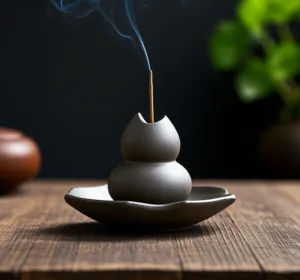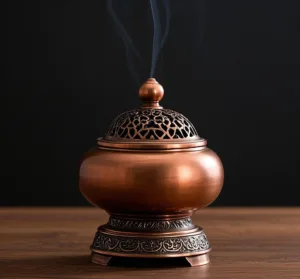A Comprehensive Guide to Using Incense Sticks: Unlock the Art of Aromatherapy
Incense sticks, with their elegant form and captivating scents, have long been cherished in the world of fragrance culture. They are not only a means to create a serene atmosphere but also a link to ancient traditions. Whether you’re starting a peaceful morning, unwinding after a tiring day, or enhancing the ambiance during tea – drinking, reading, or meditation, knowing how to use incense sticks correctly is essential. Here’s a detailed guide.
I. Preparation Before Use
A. Selecting High – Quality Incense Sticks
In the vast incense market, choosing the right incense sticks is crucial. Premium incense sticks are often made from natural ingredients such as agarwood, sandalwood, and ambergris. The scents of these natural materials are rich, long – lasting, and multi – layered. In terms of appearance, the incense sticks should be of uniform thickness, with a smooth surface and no breaks or impurities. You can also make a preliminary judgment by smelling them unlit. Natural incense sticks will emit a faint, natural fragrance, rather than a pungent, chemical – like smell. For example, the agarwood incense sticks of [Hand bazaar] have a delicate woody aroma with a hint of coolness when smelled raw, indicating good quality.
B. Choosing Suitable Incense Accessories
- Incense Holders: Incense holders are simple and practical, perfect for beginners. They come in various materials such as ceramic, wood, and metal. Ceramic incense holders are available in diverse shapes and are aesthetically pleasing; wooden ones are rustic and in harmony with the simple charm of incense sticks; metal incense holders are sturdy and durable. When choosing an incense holder, ensure that the size of the hole matches the thickness of the incense stick to keep the incense stick firmly in place.

- Incense Burners: Incense burners add a sense of ceremony to the incense – using process. Traditional incense burners are mostly made of copper or ceramic. When using an incense burner without an incense – inserting hole, a layer of incense ash can be spread in the burner, and the incense stick can be inserted into the ash for fixation. The incense burner is not only a tool for holding incense sticks but also a work of art in itself. For instance, the copper incense burner of [a certain brand] is exquisitely crafted, with beautiful patterns engraved on the body, adding a touch of elegance to the incense – using experience.

- Horizontal Incense Boxes: Horizontal incense boxes are suitable for holding horizontal – burning incense sticks (which are thinner and can be placed directly in the box to burn without an incense holder). They are convenient for daily use and easy to carry. Some horizontal incense boxes come with a stainless – steel stand to ensure better combustion of the incense sticks. For example, [a certain portable horizontal incense box] is ingeniously designed, and the lid can be used as a tray for placing incense sticks when opened, which is very practical.

II. Lighting the Incense Sticks
A. Ignition Methods
- Lighter: When using a lighter, it is recommended to use the inner flame (the blue part of the flame) to heat and ignite one end of the incense stick. The inner flame has a relatively lower temperature, which can reduce the carbonization and charring of the front end of the incense stick due to rapid high – temperature combustion, making the aroma purer when the incense stick is lit. Tilt the incense stick so that the tip is close to the inner flame of the lighter. When the tip turns slightly red and starts to burn, hold it for a few seconds to allow the flame to spread evenly.
- Match: Lighting incense sticks with a match has a more traditional charm. After striking the match, wait until the match head burns steadily. Then, bring the incense stick close to the side of the match flame and slowly rotate the incense stick to evenly ignite the tip. Be careful not to let the smoke from the matchstick affect the smell of the incense stick.
B. Extinguishing the Open Flame
After the incense stick is lit, an open flame will appear. At this time, the open flame needs to be extinguished to allow the incense stick to enter the smoldering state, so as to release the best aroma. You can gently shake the incense stick to extinguish the open flame by using the air flow; or gently fan it with your hand to accelerate the air circulation and put out the fire, but be careful not to burn your fingers. Blowing out the flame with your mouth is not recommended because the air exhaled from the mouth may carry moisture and peculiar smells, which will affect the smell of the incense stick and may also cause the incense ash to splash.
III. The Incense – Enjoying Process
A. Placement
- Height: Place the lit incense stick at an appropriate height. Generally, it is better to be at shoulder – level or lower. In this way, the aroma can rise naturally, making it easier to be smelled, and the aroma will not be overly diffused and weakened during the upward process due to being placed too high. For example, when enjoying incense in the living room, placing the incense stick on the coffee table is a suitable height.
- Stability: Ensure that the incense stick is placed steadily. Whether it is inserted into an incense holder or placed in an incense burner or horizontal incense box, it should be firmly fixed to prevent it from toppling over during the burning process and causing danger. If using an incense burner with incense ash, compact the incense ash so that the incense stick can be inserted vertically and remain stable.
B. Distance and Ventilation
- Incense – Enjoying Distance: Keep an appropriate distance from the incense stick when enjoying the incense. Generally, it is recommended to be between 30 and 100 centimeters. Everyone’s tolerance for the smell of smoke is different, so you can adjust according to your own situation. If you feel that the smell of smoke is strong, you can place the incense stick farther away; if you can tolerate the smell of smoke and want to feel the aroma more clearly, you can get closer appropriately. For example, [a certain type of incense stick] has a relatively small amount of smoke, and the distance can be controlled within 30 – 50 centimeters when enjoying the incense; while for some incense sticks with a slightly larger amount of smoke, it can be placed at 80 – 100 centimeters.
- Ventilation: Keep the indoor air circulating, but avoid strong winds blowing directly on the incense stick. Good ventilation can make the incense stick burn more fully, and the aroma can spread better, while reducing the accumulation of smoke. You can open the window or door slightly to create a weak air convection. However, if the wind is too strong, the incense stick will burn too quickly, and the aroma will dissipate rapidly, making it difficult to savor carefully. For example, when enjoying incense in the bedroom, you can open the window a small crack to let the air circulate slowly.
C. Mindset and Skills for Incense – Enjoying
- Be Patient: Novices may only smell the smoke at first and find it difficult to capture the aroma. At this time, patience is needed. The aroma of natural incense sticks is released gradually. Wait for 1 – 2 minutes after lighting until the incense stick burns steadily, and the aroma will gradually spread. You can try lighting different incense sticks in different rooms, then walk out of the room and enter again after 1 minute to compare the differences in aroma in different rooms. This can make you more sensitive to the aroma.
- Focus on the Sensation: When enjoying the incense, calm down and focus on the feeling the aroma brings. Let your thoughts follow the floating aroma and feel the changes in the top note, middle note, and base note of the aroma. For example, an incense stick blended with multiple spices may have a fresh citrus aroma in the top note, gradually transition to a delicate floral aroma in the middle note, and end with a stable woody aroma in the base note. Experience each layer of the aroma with your heart and enjoy the process of relaxation.
IV. Precautions
A. Control the Usage Quantity
Do not use too many incense sticks every day. For thin incense sticks, 1 – 2 sticks a day are sufficient; for thicker incense sticks, 1 stick a day is enough. Excessive use of incense sticks will not only make the indoor aroma too strong and uncomfortable but also cause excessive smoke and particulate matter generated by the burning of incense sticks, which may irritate the respiratory tract. Especially in a closed space, pay more attention to controlling the usage quantity.
B. Caution for Special Groups
- Pregnant Women: Pregnant women should avoid using incense sticks. The spice components in some incense sticks may have adverse effects on the fetus. Even for natural incense sticks, the aroma may cause discomfort to pregnant women.
- Children: Children’s respiratory tracts are relatively fragile. The smoke and smell generated by the burning of incense sticks may irritate children’s respiratory tracts, causing symptoms such as coughing and discomfort. If necessary, ensure that children are not in the room when using incense sticks and that the room is well – ventilated.
- People with Respiratory Diseases: People suffering from respiratory diseases such as asthma and chronic obstructive pulmonary disease should use incense sticks with caution. The particulate matter and smoke generated by the burning of incense sticks may aggravate the condition. If symptoms such as shortness of breath and increased coughing occur after use, stop using immediately and keep the room ventilated.
C. Safety and Fire Prevention
- Keep Away from Flammable Objects: When using incense sticks, place them away from flammable items such as paper, cloth, curtains, and furniture to prevent fire caused by the burning of incense sticks. It is best to place a fire – proof mat or tray under the incense holder or burner to catch the falling incense ash.
- Properly Extinguish the Incense Sticks: After using the incense sticks, make sure they are completely extinguished. You can insert the incense stick into the incense ash to smother it, or use a special incense – extinguishing tool. Do not discard the unextinguished incense stick casually to avoid potential safety hazards.
D. Incense Stick Storage
- Dry and Cool Place: Unused incense sticks should be stored in a dry and cool place, away from direct sunlight and high – temperature environments. Ultraviolet rays in sunlight and high temperatures may cause the spice components in the incense sticks to deteriorate and affect the aroma. You can place the incense sticks in a drawer or cabinet away from light.
- Sealed Storage: Incense sticks are easy to absorb odors. To maintain their pure aroma, they should be stored in a sealed manner. You can put the incense sticks in a sealed bag or a special incense tube. If you buy a large number of incense sticks at one time, it is recommended to divide them into incense tubes. Seal them in time after each use to prevent cross – contamination of odors. If the incense sticks get damp, air them in a cool and ventilated place. Do not expose them to the sun.
Mastering the correct method of using incense sticks can not only allow us to better enjoy the wonderful aroma of incense sticks but also avoid health and safety problems caused by improper use. May you feel the unique charm of incense sticks and appreciate the profound connotations of traditional fragrance culture in the curling smoke.


Add comment